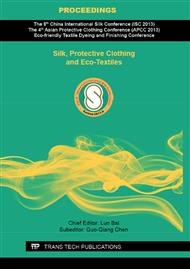p.191
p.195
p.199
p.205
p.211
p.215
p.221
p.225
p.229
Fabric Identification Based on Friction Wave
Abstract:
This paper presents an approach to identify the fabric of styles by wave of friction. First, the friction waves of typical cotton, wool, silk and hemp styled fabrics are collected under controlled conditions with a self-made device. In allusion to the non-stationary and attenuation of the signals, differences based on scopes are proposed to represent the features of wave signal in various aspects, which forms into a feature impulse. Pairwise comparisons are made among feature impulses of the four typical fabrics and it is revealed that their features are unfolded gradually from microcosmic to macrocosmic. Then, considerable amount of fabrics of each style are included to extract feature impulses, which constructed a feature library. Finally, the indeterminate fabrics are identified by the feature library, and the results are reflected in a ocular way into a discrimination chart.
Info:
Periodical:
Pages:
211-214
Citation:
Online since:
September 2013
Keywords:
Price:
Сopyright:
© 2013 Trans Tech Publications Ltd. All Rights Reserved
Share:
Citation:


